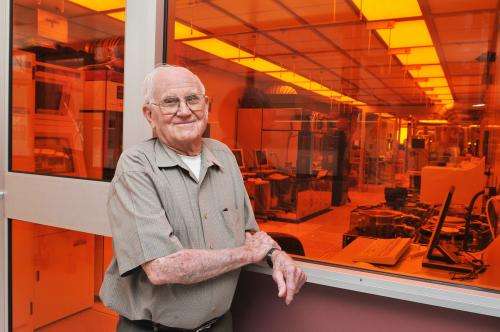Laminar-flow cleanroom inventor honored posthumously by National Inventors Hall of Fame

The inventor of the modern cleanroom, Willis Whitfield, will be honored posthumously by the National Inventors Hall of Fame for a technology that revolutionized manufacturing in electronics and pharmaceuticals, made hospital operating rooms safer and advanced space exploration.
Whitfield, the son of Texas cotton farmers who became a physicist, retired from Sandia National Laboratories in 1984 and died Nov. 12, 2012, shortly after the laminar-flow cleanroom invention's 50th anniversary. With slight modifications, his invention is still the standard.
Whitfield is among 15 inventors being inducted this year into the Alexandria, Va.-based National Inventors Hall of Fame. His work will be honored at a Washington, D.C.-area celebration in May.
"The technological solution that Willis Whitfield designed for the laminar-airflow clean room is illustrative of the long tradition of innovative research at Sandia National Laboratories. Willis' invention has stood the test of time, making the modern microelectronics industry possible," said acting Sandia Vice President and Chief Technology Officer Julia Phillips. "It's that same type of ground-breaking interdisciplinary research that advances the frontiers of science and engineering and enables our national security mission at Sandia."
A panel of experts in science, technology, engineering and patents selected the inductees. The National Inventors Hall of Fame "requires candidates to hold a United States patent that has contributed significantly to the nation's welfare and the advancement of science and useful arts."
Past inductees include Apple co-founders Steve Jobs and Steve Wozniak; Beulah Louise Henry, inventor of the ice cream freezer; and cotton gin inventor Eli Whitney.
Modest 'Mr. Clean' would have appreciated Hall of Fame honor
When Whitfield announced the invention in 1962, researchers and industrialists didn't believe it, but within a few short years, $50 billion worth of laminar-flow cleanrooms were built worldwide and Whitfield had been dubbed "Mr. Clean" by TIME Magazine.
Belva Whitfield said her late husband was always modest about his invention and the accolades he received didn't change the unassuming scientist.
"This honor means a great deal to me," she said. "I have always been so proud of Willis and his accomplishments. It is hard to say how proud I am because I don't think words are enough to express my feelings."
Belva Whitfield said her late husband would have had underlying feelings of great appreciation to be in the Inventors Hall of Fame, though outwardly he would have remained modest. "He would certainly be honored that he was in the company of Eli Whitney, Henry Ford, Samuel Morse, Wilbur and Orville Wright and so many more," she said.
Whitfield's likeness can be seen in a bronze statue that graces an entrance to Sandia's Microsystems & Engineering Science Applications (MESA) complex, where cleanrooms and clean benches based on Sandia's invention are used to manufacture precision mechanical assemblies in microsystems for national security needs.
MESA also is home to Whitfield's original lab notebooks containing diagrams of his invention and his notes as his research unfolded.
Whitfield began creating the laminar-flow cleanroom to improve the reliability of miniature mechanical components for Sandia parts. But the invention enabled the growth of the semiconductor industry, which in turn made modern electronics, computers and information technologies possible. Cleanrooms also contributed to breakthroughs in biotechnology, nanotechnology, health sciences and healthcare.
History of Sandia invention
In 1959, nuclear weapons components—mainly mechanical switching parts—were becoming smaller and microscopic dust particles were preventing Sandia from achieving the quality needed, Sandia historian Rebecca Ullrich said. The practice at the time was to tightly seal cleanrooms, wear protective clothing and vacuum often, but still contaminants entered the room and particles interfered with the precise work.
Whitfield's solution was to constantly flush out or "sweep" a room with highly filtered air. In an initial model, Whitfield designed a workbench along one wall. Clean air entered the room from a bank of filters that were 99.97 percent efficient in removing particles larger than 0.3 microns. For example, cigarette smoke blown in one side comes out the other as clean air.
The air was circulated in the room at a rate of 4,000 cubic feet or about 10 changes of air per minute. The resulting linear speed of the air is slightly more than 1 mph, which is about the same as that felt walking through a still room.
In a later modification, the air was passed down over the work area instead of across, letting gravity help carry troublesome particles into the floor, which was covered with grating. Filters underneath clean the air and it is circulated back around to re-enter the room.
Disbelief, then wonder as invention was announced
When the first cleanroom was tested instruments that counted the dust particles registered zero, causing Whitfield and others to assume they were broken, Whitfield said in 1993.
The laminar-flow cleanroom created a work environment that was more than 1,000 times cleaner than the cleanrooms in use at the time. According to tests at the time, the laminar-flow cleanroom's work area contained an average of 750 dust particles one-third of a micron in size or larger per cubic foot of air. (A micron is equal to 40-millionths of an inch.) That's compared to average dust counts of more than 1 million particles per cubic foot of air in one of the best conventional cleanrooms in use at the time.
RCA and General Motors Co. were early adopters of the cleanroom, and the predecessor to Lovelace Medical Center in Albuquerque was the first hospital to use laminar-flow cleanrooms in its operating rooms to prevent infections, Ullrich said. Eventually, Whitfield worked with NASA to provide techniques to sterilize spacecraft and assure planetary quarantines during missions to the moon and Mars.
Provided by Sandia National Laboratories




















